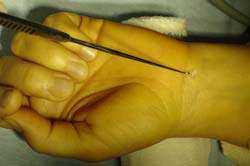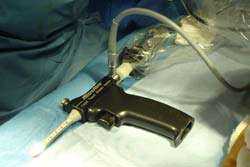Carpal tunnel syndrome
The disorders experienced during carpal tunnel syndrome are characterized by numbness of the fingers and tingling sensations, burning, which are more frequent at night or on waking.
Summary :
Definition
The median nerve enters the hand by a tunnel located at the wrist. This tunnel is made up of a bone arch, and is closed at the front by a strong ligament. The flexor tendons and the median nerve enter this channel.
Carpal tunnel syndrome is the compression of this nerve, most often by the ligament.
Diagnosis
The associated discomfort is characterised by numbing in the 3 first fingers (thumb, index and middle finger) and on the outer edge of the 4th. Tingling sensations, and burning sensations are frequently experienced at night or on waking. Added to this, pain may be felt in the hand and it may often spread to the forearm, elbow and even to the shoulder. As the disease develops the patient will experience a certain clumsiness, loss of sensitivity or even deficiency in terms of mobility of the thumb as well as a wasting of the muscles.
Electromyogram is often required (recording of an electrical current at its passage through the nerve). This shows the extent to which the nerve has been affected and the site of compression and it also indicates whether the cubital nerve has also been affected (4th and 5th fingers).
Left untreated, the nerve will gradually lose its function and the fingers will lose their sensitivity (dropping objects, inability to pick up small objects), and some thumb movements will become impossible (especially delicate movements such as picking up a coin…)
Surgical procedure

Surgery is proposed when electromyogram has shown the patient to be clearly affected or when medical treatment fails (1 or 2 infiltrations, rarely with overnight sprint).
The operation involves opening the carpal tunnel by sectioning the anterior ligament, usually by endoscopy, or open surgery by opening the palm of the hand. The procedure is most often carried out under loco-regional anaesthetic, sometimes with sedation.
Compared with conventional open surgery methods, the endoscopic method involves less post-operative pain in the palm of the hand and the patient can recover the use of his hand more quickly.
Endoscopy surgery
- Length of hospital stay: outpatient (no overnight stay)
- Anaesthetic: loco-regional (only the arm is put to sleep)
A 10 to 15 mm incision is made in the fold of the flexion of the wrist to enable the surgeon to insert a miniature system consisting of a camera with a retractable scalpel blade.

After freeing the nerve and tendons, the anterior ligament is sectioned with the camera as a monitor.The sides of the ligaments part, thus increasing the diameter of the carpal tunnel and recreating space for the median nerve.
The skin is closed using resorbable wire, and the scar protected by adhesive bands. Release from the clinic is usually a few hours after the procedure (outpatient), but a stay in hospital may always be planned in advance, depending on the state of the patient, his family circumstances or travelling time, or it may be decided that a hospital stay is necessary following surgery in particular cases.
After-surgery care
Dressings are to be changed every 2 days by a nurse visiting the patient’s home. Scarring is often hard and inflamed for several weeks. Tingling sensations in the fingertips may persist for several weeks. Once the scar has healed, physical therapy may be required for several weeks or months to enable the patient to recover the full range of hand movements.
Depending on the gravity of the initial condition, it is not always possible to recover complete finger extension.
It may be necessary for the patient to stop work depending on the extent of the disease and the nature of the work itself.
Complications after carpal tunnel decompression surgery
There is no such thing as a surgical procedure with no risk of secondary complications:
- Post-operation infection is quite easy to treat with early diagnosed cases : abnormal, throbbing pain; swelling and extensive reddening. Another operation is always a possibility.
- A swollen, painful hand with transpiration, followed by stiffening occurs rarely but is a case for concern (algodystrophy). The condition may drag out over several months or even years with possible after effects (residual pain, stiffness in the fingers and/or wrist and sometimes even in the shoulder).
- Nerve-related lesions are exceptional.
- Tingling sensations in the fingers which disappear after a few months.
- A wound in the nerve requiring further surgery.
- Recurrence is unusual, but is never to be excluded.